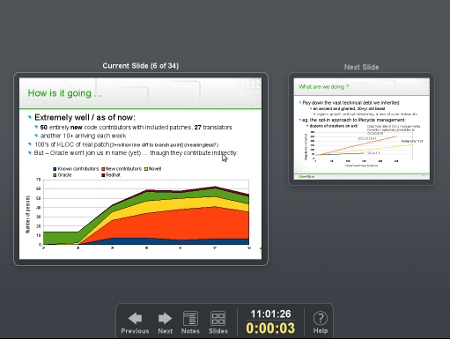Review: LibreOffice beats OpenOffice.org by a whisker
Feb 1, 2011 — by LinuxDevices Staff — from the LinuxDevices Archive — 1 viewsThe new LibreOffice open-source office suite “proves that forking isn't always the kiss of death,” says this eWEEK review. New features in the Linux-ready release — including wider document format support, SVG (Scalable Vector Graphics) import into Draw and Writer, enhanced presentation support, and an improved “save as” feature — should give OpenOffice some robust competition.
In the open source movement, the forking of a project is often a contentious matter, and can lead to the demise or mothballing of the applications that spawn from the original software. In many ways, it's a "nuclear option," as developers choose their allegiances and take their skills with them.
Often, the result is the loss of momentum as well as mindshare for all the spawned projects. But it's not an inevitable one: the January release of LibreOffice 3.3 shows that sometimes forking can lead to a positive outcome.
LibreOffice 3.3 is as polished as one might expect in a project that, for all its novelty, has many years of development work behind it. Although it's probably not going to gain widespread acceptance in the corporate world, any outfit that's looking for a solid toolset for users who don't require a lot of handholding, or integration with Microsoft's Office server applications, could do much worse than to choose it.
For many users, this will have everything necessary in a desktop-productivity suite, for an unbeatable price: free, that is.

LibreOffice and its new slide-show presenter console
(Click to enlarge)
After Oracle purchased Sun in early 2010 and terminated the OpenSolaris operating system project later that year, the dissidents who would form TDF feared that a similar fate would befall their pride and joy. Oracle was nevertheless invited to join the foundation and donate the OpenOffice.org brand, but the company asked those dissidents who were council members of the organization to resign on the grounds of conflict of interest; many did so by the end of October 2010.
However, TDF continued work on a fork of OpenOffice.org 3.3, based on development work in progress at the time of the schism. A number of open source Linux vendors, including Canonical (sponsors of the popular Ubuntu distribution), Red Hat, and Novell, adopted the TDF suite under the name LibreOffice. The Turkish Pardus 2011 Linux distribution claims the honor of being the first major release to include LibreOffice 3.3 as its default office suite.
LibreOffice 3.3 is available for BSD, Linux, Mac OS X, Unix, and Windows, and is licensed under the terms of the GNU LGPL (Lesser General Public License) version 3. Obviously, one of the most attractive features of LibreOffice is its nonexistent price-tag. Like many open source tools, its support is community-based. One should expect to see big-name Linux distributors such as Novell and Red Hat offering support packages, once they begin bundling LibreOffice with their desktop offerings.
OpenOffice.org, and more …
The suite consists of five or six applications, depending on how one counts them: the Writer word processor, the Calc spreadsheet, the Impress presentation creator and its associated Draw component, the Math equation editor, and the Base database manager (a PDF creation tool is included as well).
If those names seem familiar, they should; they are identical to those of the corresponding tools in OpenOffice.org 3.3, which was released Jan. 25, just hours after LibreOffice 3.3.
But LibreOffice is more than just a badge-engineered version of OpenOffice.org. A number of features are unique to LibreOffice. That itself is a significant achievement, considering that those have been implemented in the roughly three months since TDF forked from the OpenOffice.org effort.
Wider document format support
The significance of these differences will, of course, be more or less, depending on one's need for them. For example, someone who works with a wide range of document formats will be impressed by LibreOffice's ability to import Lotus WordPro, and MS Works files. They should also appreciate the improvements in importing WordPerfect files.

LibreOffice 3.3 Draw, showing ability to import SVG files
(Click to enlarge)
People who live and breathe for the manipulation of document files with XSLT (Extensible Stylesheet Language Transformation) also have something to cheer about. They can expect to save themselves some headaches by being able to load and save ODF (Open Document Format) documents in a flat XML format for faster processing.
I'm a big fan of the new default for the "Save As" feature of the LibreOffice applications, which only displays appropriate document formats. This won't stop a user from selecting a nonstandard format if that's really necessary, but it certainly makes it less likely that he or she will do so by accident. The new title-page creation and management tools will also appeal to different users, from the student to the most professional.
Meanwhile, the mad-scientist types (who most organizations keep tucked away in the cubicle or the office furthest from the front door) will enjoy the ability to test the as-yet-unfinished features of LibreOffice, which are exposed in the suite's "Experimental" mode.
Other nice features common to LibreOffice 3.3 and OpenOffice.org 3.3 are the matching of case for auto-corrected words and the embedding of standard PDF fonts when desired. The export of RTF (Rich Text Format) files has been substantially overhauled to fix what TDF calls "critical" errors that, in worst-case situations, result in data loss.
Installation and testing
Installing LibreOffice is a simple process once the appropriate version is in hand. However, some components require a Java virtual machine, especially in the case of the Base database manager; the installer doesn't check for one. But the first run of the application suite will prompt the user if a supported JVM is absent. The only downside to this approach is the dozen or so error messages that appear during the startup.
I tested the suite on Mac OS X 10.6.6 and on Windows 7. The only noticeable difference between the two is that the Mac version of the suite installs as an application bundle, whereas the Windows version installs as discrete components. In addition, TDF notes that the Windows installer has been integrated into a single build containing all current language versions. This reduces the size of the complete package significantly, from 75GB to 11GB.
Thanks to the common code base, many extensions and templates designed for OpenOffice.org can be expected to work on LibreOffice without modification. Some of these are even included in the distribution.
In many ways, LibreOffice 3.3 is a mature office suite, more mature in some respects than any other open source project that I can name. Although few people wanted to see OpenOffice.org fork into two camps–one driven more by the distrust of Oracle's motives than anything else, and the other driven by loyalty to the software behemoth — the result is impressive.
The dissidents who formed TDF have produced in LibreOffice a stable and versatile suite of productivity tools that any shop not closely tied to the Microsoft application stack should consider for deployment.
Availability
The stable version of LibreOffice 3.3 is now available for free download at the Document Foundation's LibreOffice page.
Other recent open source coverage in eWEEK includes a report on OpenLogic's top 10 open source projects of 2010, based on enterprise support demand.
P. J. Connolly is a writer for our sister publication eWEEK.
This article was originally published on LinuxDevices.com and has been donated to the open source community by QuinStreet Inc. Please visit LinuxToday.com for up-to-date news and articles about Linux and open source.